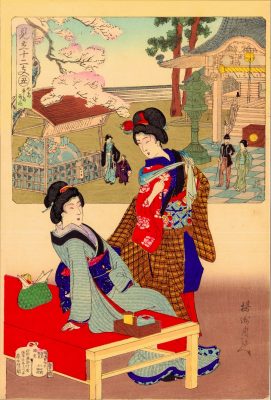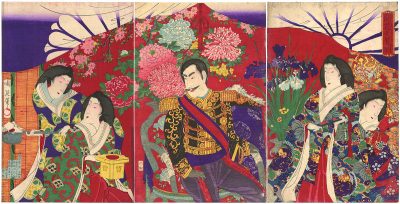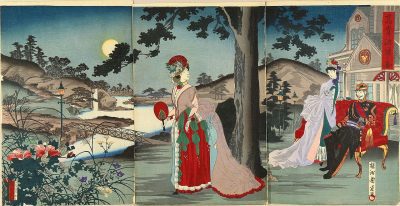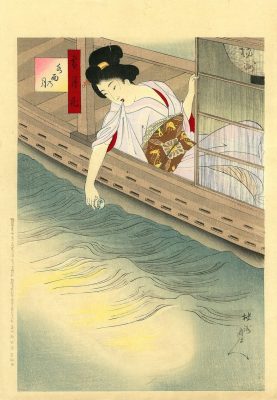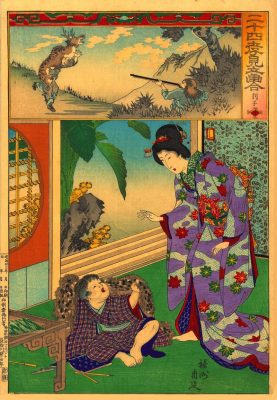Art of Japan and Changing Times through the Eyes of Yoshu Chikanobu (1838-1912)
Lee Jay Walker
Modern Tokyo Times
Yoshu Chikanobu (Toyohara Chikanobu) lived between 1838 and 1912, therefore, much of his art highlights the changing nature of Japan. The opening up of Japan after the Meiji Restoration provided many new dreams for Japanese citizens. However, it also was the start of the death knell for many artisans. This applies to the technological changes taking place and the changing values during this period of history.
Chikanobu, like other ukiyo-e artists in the Meiji era, understood the need to adapt because many new art forms were altering the artistic landscape in Japan. Western art especially impacted on the new generation of artists. Political elites also wanted to encourage modernism. Therefore, the new crème de la crème of young artists mainly adopted concepts outside of the powerful ukiyo-e art form that was so potent during the Edo period.
At the same time, technological advancements and photography were impacting greatly on ukiyo-e from a virtually negative point of view. The old ways that had nurtured art in the Edo period, along with other forms of art, were being challenged by many new art movements. Also, photography would eat away at the need for ukiyo-e because it could not compete on a technological level playing field.
Chikanobu highlights an array of subjects in his art and this applies to the power of the past to the changing nature of Japanese society. He also depicted powerful historical figures in Japanese history to highlighting the nationalist side of the Meiji period which applies to war. Also, when you view Chikanobu’s art you can visually witness the imperial aspects of Western powers, which were being replicated in dress styles when it applied to elites.
Cultural wise, Chikanobu also painted many adorable themes. This applies to the Japanese tea ceremony, ikebana, kabuki, fashion in the changing Japan, and a plethora of other subjects. In this sense, Chikanobu opens up many aspects of Japan related to many themes. These themes also apply to the “old world” and “new world.”
The Toshidama Gallery (http://toshidama.wordpress.com) comments that “Chikanobu is one of the giants of the Meiji era of Japanese Woodblock prints. With Kunichika and Yoshitoshi, Chikanobu distinguished the turmoil of Japanese culture as it came to terms with the new age. Like them, his life and career were inextricably linked to the upheavals in Japanese history and the near civil wars that characterized the time.”
Chikanobu and the series titled A Mirror of the Ages is also a classic because of the rich cultural themes related to women and fashion throughout the changing times. The Toshidama Gallery highlights this series strongly by stating that “This whole series is one of the outstanding achievements of late nineteenth century Japanese art. One of his best series, A Mirror of the Ages showed women by fashion and hair style throughout history. There is of course the longing for the past and yet these prints are unmistakably modern and of their time….The quality of printing is outstanding, especially in Chikanobu’s use of white for the rendering of the powdered faces. It is often forgotten by art historians that this was the period about all others when the technique of woodblock printing achieved its zenith whilst at the same time there were artists of stature to execute it.”
Other adorable print series include “Chiyoda no Ooku” (Court Ladies of the Chiyoda Palace) and “Shin Bijin” (True Beauties). Of course, Chikanobu produced many amazing pieces of art but both the above-named series relate to genuine aspects of female beauty in Japan. This is highlighted by traditional clothing to the changing nature of the time which applies to Western dress styles.
In a past article about Chikanobu, I comment that “Chikanobu not only witnessed the new revolutionary period and how elites looked to the West but by the late 1880s and early 1890s nostalgia also returned. Obviously, for the masses, they were outside both themes and the only important thing was survival and adapting.”
The art of Chikanobu stands out dramatically and this not only applies to the exquisite skills that he was blessed with, but also to the themes that Chikanobu highlights. He certainly provides many glimpses into Japan which relate to the “old world,” cultural aspects of Japan, and the modernization of the Meiji period.
Overall, Chikanobu is one of the greats of the ukiyo-e art movement despite the onset of modernity that would alter the artistic landscape of Japan.
http://www.toshidama-japanese-prints.com/item_216/Chikanobu-A-Mirror-of-the-Ages.htm
Please visit http://toshidama.wordpress.com for more articles and information.
Please visit http://toshidama-japanese-prints.com/ – On our site, you will see a wonderful selection of Japanese woodblock prints for sale. Ukiyo-e (the Japanese name for woodblock prints of the 18th and 19thcenturies) are beautiful, collectible and a sound financial investment.
Modern Tokyo News is part of the Modern Tokyo Times group
DONATIONS to SUPPORT MODERN TOKYO TIMES – please pay PayPal and DONATE to sawakoart@gmail.com
http://moderntokyotimes.com Modern Tokyo Times – International News and Japan News
http://sawandjay.com Modern Tokyo Times – Fashion
https://moderntokyonews.com Modern Tokyo News – Tokyo News and International News
http://global-security-news.com Global Security News – Geopolitics and Terrorism
PLEASE JOIN ON TWITTER
https://twitter.com/MTT_News Modern Tokyo Times
PLEASE JOIN ON FACEBOOK
https://www.facebook.com/moderntokyotimes
Some art and cultural articles by Modern Tokyo Times are republished in order to highlight the unique reality of Japan to our growing international readership.
